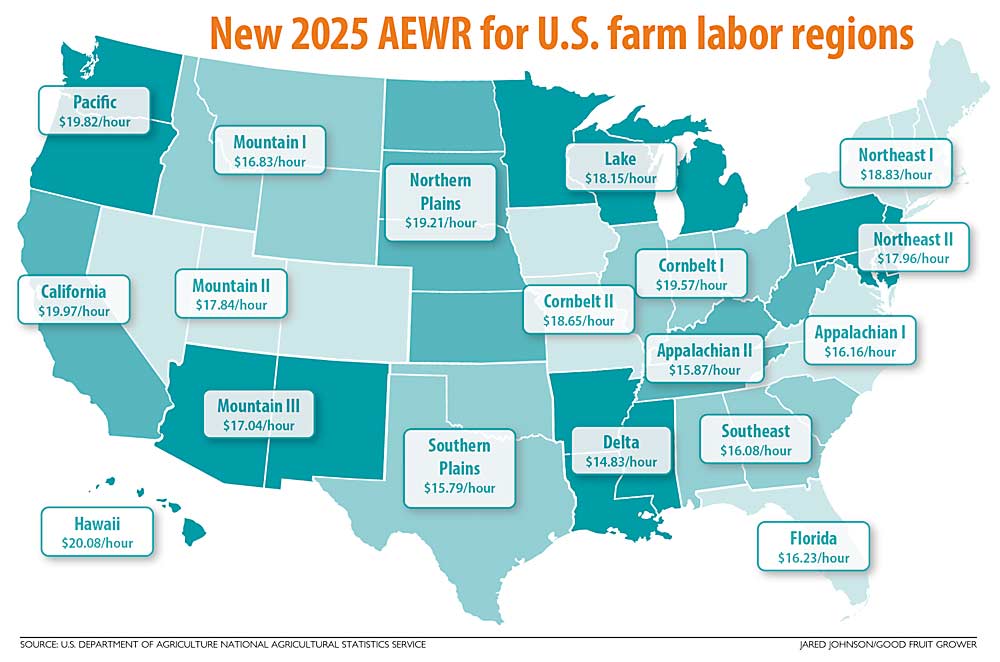—story by Kate Prengaman
—graphic by Jared Johnson

H-2A wages will rise again this year for most — but not all — U.S. growers who contract with temporary agricultural workers. Wages remain highest in the specialty-crop-heavy West Coast states, but steep increases in the Southeast and a handful of other regions bring wages for almost all U.S. H-2A employers to at least $16 per hour.
Notably, in the upper Midwest region of Michigan, Wisconsin and Minnesota, the wage will fall 2 percent, from $18.50 to $18.15. Meanwhile, in Washington and Oregon, the wage will go up from $19.25 to $19.82, a 3 percent increase, while California growers face a 1 percent increase, landing at $19.97.
In November, the U.S. Department of Agriculture released its annual wage survey that serves as the basis for the Adverse Effect Wage Rates the Department of Labor will set for 2025. Those wages were not yet published in the Federal Register, which puts them into effect, when this issue of Good Fruit Grower went to press. That formalization was expected at some point in December, according to Kate Tynan, senior vice president for the Northwest Horticultural Council, which advocates for the tree fruit industry on federal policy issues.
“I would also like to emphasize that a 2.9 percent increase in wages is still significant and challenging for growers to implement,” she said. “We at NHC are still pursuing a freeze of the AEWR at 2024 levels.”
Across the country, the survey found that the average wage for agricultural workers in both field and livestock combined rose 3.25 percent from 2023 to 2024. That annual average of the gross hourly wage in each region in 2024 becomes the new AEWR for the most common crop activities. Wage rates for truck drivers and other specialized equipment operators will be set separately, Tynan said.
Increases of nearly 10 percent will hit the Southeastern U.S., and Hawaii, at $20.08, will surpass California with the highest AEWR in the country. Idaho growers will see a 1.75 percent increase to $16.83. In New York and the rest of the Northeast, the AEWR will rise nearly 6 percent to $18.83. In Pennsylvania, New Jersey and Maryland, the AEWR will be $17.96, a 4.4 percent increase.
The widespread nature of the cost increases may make H-2A reform a more important policy issue across the U.S., said Jon DeVaney, president of the Washington State Tree Fruit Association.
“If we are going to ask D.C. to do something about this issue, it helps to have national pressure,” he said.
Tynan agreed.
“Our rates are still much higher than other parts of the country, but there could be some value from additional policy pressure — from members of Congress and members of the new administration — from these regions that saw 9 percent increases, which as our growers know, is impossible to plan for,” she said.
New H-2A rules include a provision that the AEWR takes effect immediately upon publication. That will be the case for Washington and Oregon, Tynan said, while implementation of that rule has been stayed for 17 other states who are party to a lawsuit challenging its constitutionality, led by the Georgia Fruit and Vegetable Growers Association. In those states, a date will be set for the new wages to take effect.
Numerous lawsuits pending nationwide could affect the implementation of the H-2A program regulations this year; however, those cases will not affect the AEWR rates for 2025. •







Leave A Comment